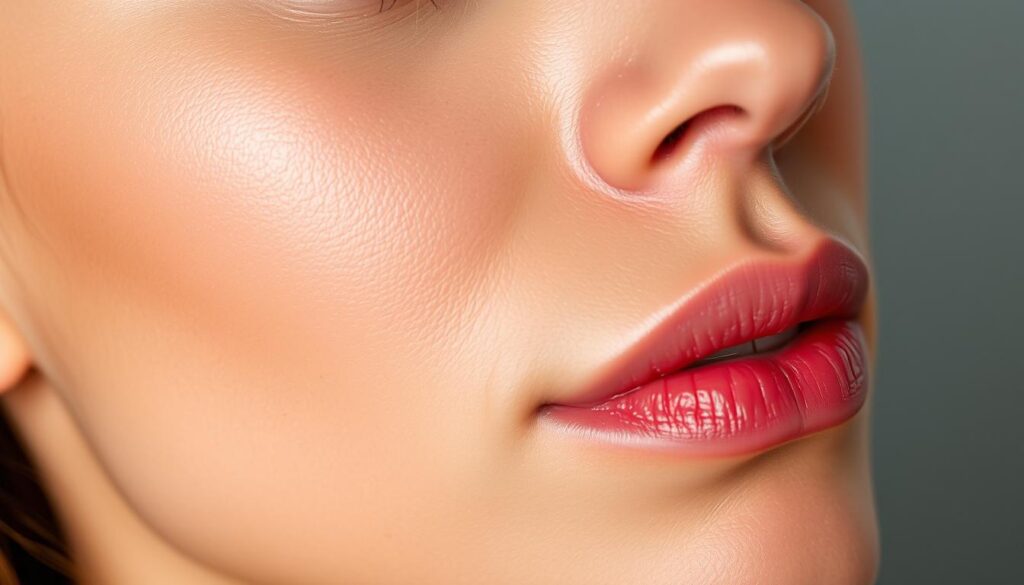If your face often feels tight, red, or irritated, you might have a delicate complexion. This type of complexion requires extra care to avoid discomfort and maintain a healthy glow. Understanding your specific needs is the first step toward creating a routine that works for you.
Many people with delicate complexions experience dryness, redness, and irritation due to a weakened barrier. Ingredients like sulfates, alcohol, and synthetic fragrances can worsen these issues. Opting for soothing components such as oat beta glucan and green tea polyphenols can help calm and protect your face1.
A well-rounded routine includes cleansing, hydrating, and sun protection. These steps ensure your barrier stays strong and healthy. Dermatologists recommend using gentle products and avoiding harsh exfoliants to prevent further irritation2.
Ready to learn more about crafting the perfect routine? Let’s dive into the essential steps and products that can make a difference for your unique needs.
Understanding Sensitive Skin
Does your face often feel uncomfortable after using certain products? You could have a reactive complexion. This type tends to show redness, itching, or tightness when exposed to irritants3. Understanding what defines it is the first step toward proper care.
What Defines Reactive Complexion?
A reactive complexion is characterized by its tendency to react strongly to triggers. These can include skincare products, weather changes, or even stress. Common signs include redness, burning, and tightness4.
Not all reactions are the same. Some people may experience dryness, while others deal with itching or flakiness. This makes it uniquely personal and requires tailored care5.
The Role of a Weakened Barrier
A compromised barrier is often the root cause of reactivity. When the barrier is weak, irritants and allergens can penetrate easily, leading to discomfort3. Environmental factors like pollution and extreme temperatures can worsen this condition.
To protect your face, opt for hypoallergenic and fragrance-free products. These minimize the risk of irritation and help strengthen the barrier over time4.
- Common Triggers: Fragrances, dyes, and harsh chemicals.
- Environmental Factors: Pollution, wind, and UV rays.
- Lifestyle Factors: Stress, lack of sleep, and poor diet.
Understanding your type and condition is crucial. This knowledge helps you choose the right products and avoid unnecessary discomfort.
Identifying Your Skin Triggers and Caring for Your Barrier
Pinpointing the causes of irritation can help you care for your complexion more effectively. Many factors, from environmental conditions to specific ingredients, can upset your face. Understanding these triggers is essential for maintaining a healthy and balanced routine.
Common Irritants and Environmental Factors
Your face can react to a variety of triggers. Harsh chemicals like sulfates and synthetic fragrances are common culprits. Environmental factors such as pollution, wind, and extreme temperatures can also cause discomfort6.
Studies show that up to 60% of individuals with a reactive complexion have a compromised barrier, making them more susceptible to these irritants6. To protect your face, opt for hypoallergenic and fragrance-free products. These minimize the risk of irritation and help strengthen your barrier over time7.
Tracking Your Skin’s Reactions
Keeping a diary of your skin’s responses can help you identify specific triggers. Note when redness, itching, or tightness occurs and what products or conditions were involved. This practice helps you pinpoint patterns and adjust your routine accordingly7.
For example, if you notice discomfort after using a new cleanser, it might contain an ingredient that doesn’t agree with your face. Switching to a gentle, hydrating option with glycerin can make a significant difference6.
Actionable Tips:
- Avoid products with alcohol and synthetic fragrances, as these can worsen irritation6.
- Use a gentle cleanser and moisturizer to maintain your barrier’s health.
- Patch test new products to ensure they don’t cause adverse reactions7.
By understanding your triggers and caring for your barrier, you can reduce discomfort and keep your face looking its best.
Sensitive Skin: How to Build a Gentle Skincare Routine
Creating a routine for a reactive complexion doesn’t have to be overwhelming. By focusing on three key steps, you can nurture your face and reduce irritation. Let’s break down the essentials for a gentle and effective skincare routine.
Step 1: Cleanse with Care
Start your routine with a mild, hydrating cleanser. Avoid harsh surfactants that strip away natural oils. Instead, opt for formulas with soothing ingredients like glycerin or oat extract. These help maintain moisture while removing dirt and impurities8.
Use lukewarm water to rinse your face. Hot water can dry out your complexion, while cold water may not effectively remove residue. After cleansing, gently pat your face dry with a soft towel to avoid irritation9.
Step 2: Hydrate and Nourish
Hydration is key to supporting your skin barrier. Choose a moisturizer with ingredients like ceramides or hyaluronic acid. These help lock in moisture and strengthen your face’s natural defenses8.
Apply your moisturizer while your face is slightly damp. This helps seal in hydration and leaves your complexion feeling soft and smooth. Consistent use can reduce redness and improve overall texture9.
Step 3: Shield Your Skin with Sunscreen
Daily sun protection is non-negotiable. Use a broad-spectrum sunscreen with an SPF of 30 or higher, like Trilipiderm’s Protective Day Crème. This shields your face from harmful UVA and UVB rays, preventing sunburn and long-term damage8.
Apply sunscreen as the final step in your morning routine. Reapply every two hours if you’re spending time outdoors. This simple habit can make a significant difference in maintaining a healthy complexion9.
By following these steps consistently, you can create a routine that supports your unique needs. Remember, patience and care are the foundations of a healthy, glowing face.
Choosing the Right Skincare Products for Sensitive Skin
Navigating the world of skincare can be tricky, especially when your complexion is prone to irritation. The right products can soothe and protect, while the wrong ones may worsen redness and discomfort. Knowing what to look for on ingredient labels is the first step toward building a routine that works for you.
Ingredients to Embrace
Certain ingredients are particularly beneficial for delicate complexions. Hyaluronic acid helps lock in moisture, keeping your face hydrated without causing irritation10. Ceramides strengthen the skin barrier, reducing sensitivity over time10. Natural components like aloe vera and oat extract calm redness and provide a soothing effect11.
When shopping, look for products labeled non-comedogenic and hypoallergenic. These are less likely to clog pores or trigger adverse reactions. Plant-based compounds, such as green tea polyphenols, are also excellent choices for their gentle, nourishing properties10.
Ingredients to Avoid
Some ingredients can be harsh on delicate complexions. Sulfates and alcohol strip away natural oils, leading to dryness and irritation10. Synthetic fragrances and dyes are common irritants that can cause redness and itching11.
Always check the ingredient list before purchasing. Avoid products with harsh chemicals or unnecessary additives. Opt for fragrance-free and alcohol-free formulas to minimize the risk of discomfort10.
Building a routine tailored to your needs can significantly improve your complexion. Start with a gentle cleanser and a hydrating moisturizer. Patch test new products before full application to ensure they work well for you. With the right choices, you can reduce irritation and achieve a healthier, more balanced look.
Crafting a Daily Routine for Your Sensitive Skin
Taking care of a reactive complexion requires a thoughtful approach to your daily habits. A consistent routine can help reduce discomfort and keep your face looking its best. Let’s explore how to structure your morning and evening steps for optimal results.
Morning Routine Essentials
Start your day with a gentle cleanse to remove impurities without stripping natural oils. Studies show that 80% of dermatologists recommend this as the first step for delicate complexions12. Use lukewarm water and pat your face dry with a soft towel to avoid irritation.
Follow up with a hydrating toner if your complexion feels tight. Finish with a moisturizer that includes broad-spectrum SPF. Daily use of sunscreen can reduce the risk of skin cancer by up to 50%12. This step is essential for protecting your face from harmful UV rays.
Evening Routine and Weekly Boosts
In the evening, focus on removing impurities and providing intensive moisture. Begin with a double cleanse to ensure all dirt and makeup are gone. Follow with a targeted treatment, like a serum, to address specific concerns. Clinical studies suggest that serums can improve hydration levels by up to 30%12.
End your routine with a rich moisturizer to lock in moisture overnight. Weekly masks and gentle exfoliation can boost hydration and improve texture. Consistency is key—90% of individuals with delicate complexions see improvement with regular care12.
Adjust your routine based on seasonal changes and your complexion’s reactions. Listening to your face ensures it gets exactly what it needs to stay healthy and balanced.
Advanced Tips for Sensitive Skin Management
Managing a reactive complexion effectively requires more than just the right products. It’s about understanding how to introduce new treatments and protect your face from external stressors. Here are some advanced strategies to help you maintain balance and reduce flare-ups.
Patch Testing and Gradual Introductions
Before using a new product, always perform a patch test. Apply a small amount to your forearm and monitor for 24-48 hours. Studies show that 30-50% of individuals with reactive complexions may react to new ingredients13. This step helps you avoid adverse reactions like redness or itching.
Introduce new treatments gradually. Start with one product at a time and wait a week before adding another. This approach allows you to evaluate your face’s tolerance and identify any triggers. For example, serums and treatments should be integrated slowly to avoid overwhelming your complexion14.
Reading labels carefully is crucial. Avoid products with alcohol, sulfates, or synthetic fragrances, as these are common irritants15. Opt for hypoallergenic formulas to minimize the risk of discomfort.

Managing Stress and Environmental Triggers
Stress can worsen reactive complexions, leading to flare-ups. Incorporate stress management techniques like meditation or yoga into your routine. Research shows that these practices can reduce skin flare-ups by 20%15.
Environmental factors like pollution and allergens also play a role. Protect your face by using a broad-spectrum sunscreen daily. Sunscreen with SPF 15 or higher can shield your complexion from harmful UV rays13. Additionally, consider wearing a hat or scarf in extreme weather conditions.
Stay patient and observant. Track your face’s reactions to different conditions and adjust your routine accordingly. Advanced management strategies can significantly reduce discomfort and improve your overall complexion.
Adapting Your Routine for Different Skin Types
Your complexion’s needs can vary greatly depending on its unique characteristics. Whether your face tends to be dry, oily, or a mix of both, customizing your routine ensures better results. Let’s explore how to tailor your care for each profile.
Customizing for Dry, Oily, and Combination Skin
Dry skin often feels tight and flaky, especially in harsh weather. Opt for richer moisturizers with ingredients like ceramides and hyaluronic acid to lock in moisture. The National Eczema Association recommends CeraVe Moisturizing Cream for its hydrating properties16.
Oily skin, on the other hand, benefits from lightweight, non-comedogenic formulas. Look for gel-based moisturizers like Neutrogena Hydro Boost Gel-Cream, which provides hydration without clogging pores16. Ingredients like oatmeal can also help absorb excess oil and calm irritation16.
Combination skin requires a balanced approach. Use a creamy moisturizer for dry areas and a water-based formula for oily zones. Products like Fenty Skin Fat Water Pore-Refining Toner Serum are ideal for this profile16.
| Skin Type | Recommended Products | Key Ingredients |
|---|---|---|
| Dry | CeraVe Moisturizing Cream | Ceramides, Hyaluronic Acid |
| Oily | Neutrogena Hydro Boost Gel-Cream | Oatmeal, Glycerin |
| Combination | Fenty Skin Fat Water Pore-Refining Toner Serum | Niacinamide, Cactus Flower |
Monitor your skin’s condition as seasons and lifestyles change. If you’re unsure about your profile, consult a dermatologist for personalized advice. Customization is key to maintaining a healthy and balanced complexion.
Essential Ingredient Insights for Sensitive Skin
Understanding the ingredients in your skincare products can make a big difference in managing a reactive complexion. The right components can soothe and hydrate, while the wrong ones may lead to irritation and discomfort. Let’s explore which ingredients to embrace and which to avoid for a healthier, calmer face.
Beneficial Ingredients and Their Benefits
Certain ingredients are particularly helpful for delicate complexions. Hyaluronic acid locks in moisture, keeping your face hydrated without causing irritation17. Ceramides strengthen the barrier, reducing sensitivity over time17. Natural components like aloe vera and oat extract calm redness and provide a soothing effect18.
Niacinamide is another star ingredient. It helps reduce redness and improves texture, making it a must-have for reactive complexions17. Studies show that formulations with prickly pear extract can enhance barrier function by 25%19. Look for these ingredients in your cleansers, moisturizers, and serums for a gentler routine.
Harmful Additives to Steer Clear Of
Some ingredients can worsen reactivity. Sulfates and alcohol strip away natural oils, leading to dryness and irritation17. Synthetic fragrances and dyes are common irritants that can cause redness and itching18.
Essential oils, while natural, can also trigger reactions in some individuals. Always check the ingredient list before purchasing. Opt for fragrance-free and alcohol-free formulas to minimize the risk of discomfort17.
| Beneficial Ingredients | Harmful Additives |
|---|---|
| Hyaluronic Acid | Sulfates |
| Ceramides | Alcohol |
| Niacinamide | Synthetic Fragrances |
| Aloe Vera | Essential Oils |
By choosing products with the right ingredients, you can reduce irritation and achieve a healthier, more balanced complexion. Always read labels carefully and patch test new products to ensure they work well for you.
Conclusion
Caring for a delicate complexion starts with understanding its unique needs. By focusing on proper cleansing, hydration, and sun protection, you can reduce irritation and strengthen your barrier20. Choosing the right products, free from harsh additives, is essential for maintaining balance and calm.
Consistency is key. Studies show that sticking to a routine for 4-6 weeks can lead to noticeable improvements20. Patch testing new products and introducing them gradually helps avoid adverse reactions21. Understanding your triggers and adapting your care to your lifestyle ensures long-term success.
If persistent issues arise, consult a dermatologist for personalized advice. With patience and the right approach, you can rediscover your natural glow. Start today and take the first step toward healthier, happier skin.



